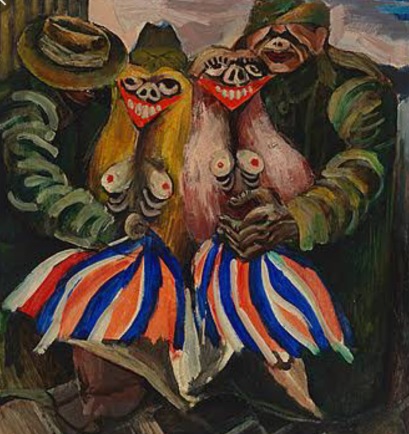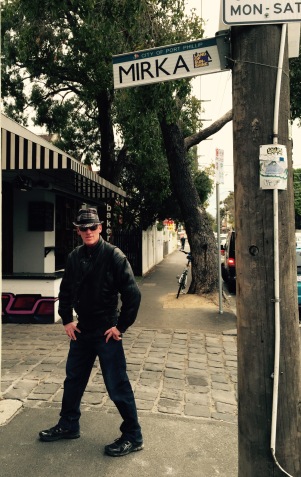During war years, the Melbourne art scene dragged itself away from the safe bush scenes and began making social comments through expressive art. Urban hardships were the realities of the day, and the war brought home Surreal experiences. The struggle for survival opened up a marginal void, that the new bohemia were ready to fill. Eccentric aristocrats were the lifeblood of Melbourne Artists during the new Modern Movement. There were two major camps that drew in the cream of new art. The Reeds established a shelter for artists at Heide, in Heidelberg and Meric Boyd’s ‘Open Country’, in Murrumbeena, challenged the status quo.
Both had an open door policy for emerging artists; Meric Boyd built a kiln on the property and encouraged his children to be active in the hub that gathered there. The kiln would eventually fire-up Arthur Boyd and John Perceval’s, emotive and provocative sculptures.
Perceval; The Acrobat Angel : Boyd; 30 Pieces of silver
Boyd’s style grew in Open Country but manifested in the South Melbourne paintings. During the dark war years, he suffered from a depression.Like Perceval he saw the depravity of urban life and drew upon motifs that would be symbols to became part of his pictorial dialogue.

‘the man in wheelchair, the cripple on crutches, the tormented naked lovers, the beast, the chimney stacks and the gargoyles.’ Sasha Grishin
Boyd, Percival and Tucker explored the moral decline brought on by the American troops stationed in Melbourne; the confronting work does not shrink from climate of prostitution in the City. England sent Australian troops to India to guard its riches and the Americans stepped in to protect our land and befriend it’s women.

Albert Tucker Victory Girls 1943
The Reeds harboured Sidney Nolan as he avoided military duty and the Kelly series expressed his new outlaw status.Nolan was Sunday’s prize bull, she wanted Europe to embrace him, but the modern world rarely looked our way.
Joy Hester was coaxed and chastised by the wilful Sunday and she would occasionally slip over the river to the Boyd’s camp. Tucker would have a love/hate relationship with the Heide crew, as his personal involvement with Hester intensified.Their Love Child Sweeny, brought Mike Brown into the brood during the later years.

The Reeds were determined for Melbourne to be the capital of figurative art and hoped to expel the growing appeal of the American movement of Abstract Expressionism.The 1959, Antipodean Exhibition drew in artists from other camps who signed and battled over the direction of Melbourne Art. John Brack supported the figurative art stance but withdrew from the show due to the politics. He had avoided the ‘hot-bed of art groups and shared a studio with his life long friend, and fellow artist Fred Williams.

During the war years the Paris Art scene was kept in darkness. American Abstract Expressionists stole the limelight, it could have been the Australian figurative movement and for good or bad, it could have led world art into the heart of Melbourne. It was a radical and unique period in art history.
The other major art groups in early Melbourne were Dunmoochin which included Clifton Pugh and John Olsen. Montsalvat was set up by Justus Jorgensen and drew strongly from European influences, particularly in its architecture.The town was relatively young and most of the artists had studied and knew each other through the Gallery Art School.
Mirka Mora arrived in Melbourne, like many immigrants, her family was escaping the persecutions and atrocities of the war. Local artists frequented the Mirka coffee shop and Mora flirted between Heide and Open Country camps.She sewed a dress for Sunday and her children played amongst the Boyd’s kilns. She supported Joy Hester by exhibiting her on the café walls and as her families hospitality businesses grew, so did her presence as an Artist.

Mirka Cafe opening
Charles Blackman was a regular customer at Mora’s cafe, the family had a reputation for supporting and feeding local artists.Despite the energy and personal finances Art Patrons offered, the artists knew that they would have to leave Australia to further their careers. The public enjoyed modern housing,appliances and clothes but they were closed to new ideas and clung onto Colonial Art.

Open Country at Murrumbeena
‘In 1963 after having achieved a degree of recognition and financial security, Percival and his family joined the general exodus of artists and left Australia.’ Sasha Grishin
Boyd had already moved his family to England. Open Country was torn down, to make way for a block of flats.

Banner Photo Athur Boyd butterfly Man 1943
John Brack NGV 2009; p156
Australian Surrealism and its Echoes NGV 2015; p70
The Heart Garden Sunday Reed and Heide Janine Burke Vintage 2004
Australian Art A History, Grishan S, The Miegunyah Press,2015; p333-347


